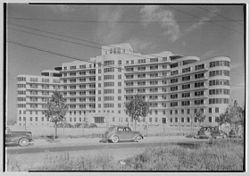Triboro Hospital for Tuberculosis
| Triboro Hospital for Tuberculosis | |
|---|---|
 | |
| Established | 1903 |
| Opened | 1916 |
| Closed | 2000 |
| Current Status | Closed |
| Building Style | Single Building |
| Alternate Names |
|
History[edit]
With the need for more facilities to deal with tuberculosis raging through New York, the city bought the twenty-two-acre Haack farm in 1903. The Queensboro Hospital for Contagious Diseases would later open on the property on June 29, 1916. Adjacent to the property, on October 30, 1935, the Queens General Hospital would open. Barely a year later the old TB complex was merged into the regular hospital.
In 1936, the city began construction on a new tuberculosis hospital near the Queens hospital and pavilion. With the use of Public Works Administration funds, ground broke for the new building in 1938 and opened in 1941. Patients were moved into the new institution from the surrounding hospitals.
Throughout the 50s and 60s, Triboro took in TB patients from other surrounding institutions as those places closed due to the declining need for tuberculosis focused hospitals. By 1959, the hospital boards of Queens General and Triboro Hospital were combined completing the merger of the hospitals. Finally, in 1970, Triboro shifted into a normal hospital within the Queens Hospital complex.
However, by the early seventies, the entire complex, both earlier TB and General Hospital buildings, were considered below health standards. The structures were antiquated, and the institution underfunded and underequipped. A proposal to move the institution and close the complex, however, was shut down due to community opposition and a city financial crisis.
By the late 80s, many of the older 30s PWA buildings were torn down for more modern buildings. However, the original Triboro TB building built in 1937 was saved and renovated. It then operated as a drug treatment facility with a psychiatric unit on its third floor.
However, the old TB building continued to deteriorate causing the city to relocate its services to other buildings. Due to its historic status, the city and surrounding communities chose to save the structure and turn it into affordable housing. The building was placed on the National Register of Historic Places by New York State in 2018. This allowed for tax credits and redevelopment funds for the creation and retention of 13 affordable housing developments.



